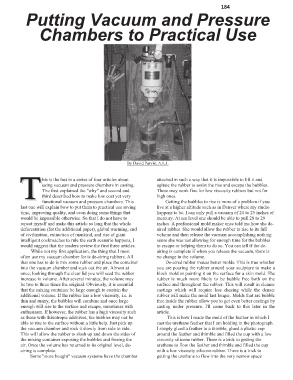Page 188 - Casting of Angels- Dave Parvin
P. 188
184
Putting Vacuum and Pressure
Chambers to Practical Use
By David Parvin, A.L.I.
his is the last in a series of four articles about attached in such a way that it is impossible to lift it and
using vacuum and pressure chambers in casting. agitate the rubber to assist the rise and escape the bubbles.
The first explained the "why" and second and These may work fine for low viscosity rubbers but not for
third described how to make low cost yet very high ones.
functional vacuum and pressure chambers. This Getting the bubbles to rise is more of a problem if you
last one will explain bow to put them to practical use saving live at a higher altitude such as in Denver where my studio
time, improving quality, and even doing some things that happens to be. I can only pull a vacuum of 24 to 25 inches of
would be impossible otherwise. So that I do not have to mercury. At sea level one should be able to pull 28 to 29
repeat myself and make this article so long that the whole inches. A professional mold maker once told me how she de-
deforestation (for the additional paper), global warming, end aired rubber. She would allow the rubber to rise to its full
of civilization, extinction of mankind, and rise of giant volume and then release the vacuum accomplishing nothing
intelligent cockroaches to rule the earth scenario happens, I sense she was not allowing for enough time for the bubbles
would suggest that the readers review the first three articles. to escape or helping them to do so. You can tell if the de-
While not my first application, the thing that I most airing is complete if when you release the vacuum, there is
often use my vacuum chamber for is de-airing rubbers. All no change in the volume.
that one has to do is mix some rubber and place the container De-aired rubber makes better molds. This is true whether
into the vacuum chamber and suck out the air. Almost at you are pouring the rubber around your sculpture to make a
once, looking through the clear lid you will seed the rubber block mold or painting it on the surface for a skin mold. The
increase in volume. After several minutes, the volume may rubber is much more likely to be bubble free both on the
be two to three times the original. Obviously, it is essential surface and throughout the rubber. This will result in cleaner
that the mixing container be large enough to contain the castings which will require less chasing while the denser
additional volume. If the rubber has a low viscosity, i.e. is rubber will make the mold last longer. Molds that are bubble
thin and runny, the bubbles will combine and once large free inside the rubber allow you to get even better castings by
enough will rise to the surface and escape, sometimes with casting under pressure. I'll come back to this later in the
enthusiasm. If however, the rubber has a high viscosity such article.
as those with thixotropic additives, the bubbles may not be This is how I made the mold of the feather in which I
able to rise to the surface without a little help. Just pick up cast the urethane feather that I am holding in the photograph.
the vacuum chamber and rock it slowly from side to side. I simply glued a feather to a thimble, glued a plastic cup
This will allow the rubber to slosh up and down the sides of around the feather and thimble and filled the cup with a low
the mixing container exposing the bubbles and freeing the viscosity silicone rubber. There is a trick to getting the
air. Once the volume has returned to its original level, de- urethane to flow the feather and thimble and filled the cup
airing is complete. with a low viscosity silicone rubber. There is a trick to
Some "store bought" vacuum systems have the chamber getting the urethane to flow into the very narrow space

